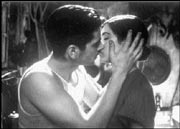THE DEVIL’S BACKBONE
directed by Guillermo del Toro with Fernando Tielve, Marisa Paredes, and Eduardo Noriega opens Dec. 21 at Harvard Exit
WHAT IS A GHOST? asks The Devil’s Backbone, and then does its damnedest to answer in myriad damn scary ways. From the creepy, darkly aquatic opening sequence, this film has you squinting through its many shadows, both greedy for, and terrified of, what you might see.
As the Spanish Civil War crawls toward its bloody end, 10-year-old Carlos (Fernando Tielve) is abandoned at a makeshift orphanage sheltering Republican children that stands alone in a vast, baking plain. An unexploded Fascist bomb is lodged in the middle of its courtyard; it’s been defused, if you care to believe that, but still stands, an obelisk of tension at the center of this microcosm. Carlos is immediately subjected to hazing by the other boys, but it takes more than the corporeal to intimidate him. Accordingly, he is just as quickly initiated by the One Who Sighs, an apparition of the midnight corridors, echoing dormitories, and (of course) horrifying, cavernous cellars of the Santa Lucia School. Not since this past summer’s The Others—also directed by a rising star of new Spanish cinema, Alejandro Amenᢡr—has such fine work been done with little children wandering about in the dark.
Meanwhile, the few remaining adults of the institution struggle with the war and, more interestingly, one other. The hardened headmistress (Marisa Paredes), with her fantastically medieval prosthetic leg, harbors secrets, nocturnal and otherwise. The elegant, beloved professor C᳡res (Federico Luppi) is the moral center of the school and the film, yet is doomed by the impotence of poetry and science in a world gone mad with violence. Played by burning-hot Eduardo Noriega (see Burnt Money, page 31), caretaker Jacinto is the embodiment of handsome, cruel totalitarianism, with his counterpart, young Conchita, the picture of innocent beauty and, eventually, virginal sacrifice.
While the background of the war and its republican cause is largely peripheral to Backbone, that outside desperation and ugliness haunts the orphanage. As things go from bad to worse, the One Who Sighs turns up more and more frequently—and turns demanding. (Junio Valverde is spectacular as this wavering, ghost-white corpse with blood eerily leaking from his head wound.) Soon the boys are sharpening sticks and flies are landing on corpses, as the ghosts multiply and the tension, impossibly, mounts. What, finally, is a ghost? In the chilling, well-rendered Backbone, if tragedy is not to repeat itself, it’s history that must be exorcized.








